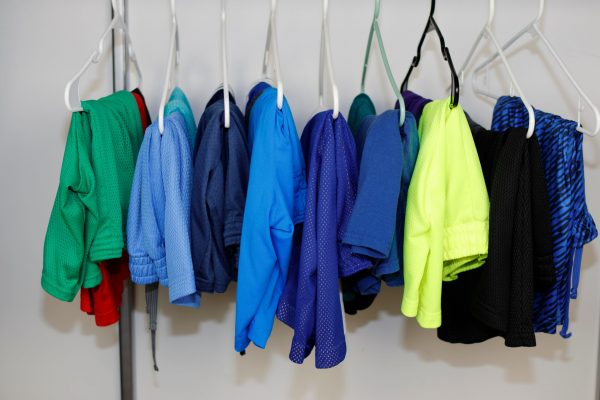

Featured
Why Does My Treadmill Smell Like Burning
Modified: August 18, 2023
Discover why your treadmill smells like burning with our featured guide. Learn the causes and solutions to keep your workout equipment safe and odor-free.
Introduction
Have you ever noticed a peculiar smell emanating from your treadmill during your workout sessions? It’s not uncommon for treadmills to emit a burning odor, which can be unsettling and concerning for users. This article aims to uncover the reasons behind this phenomenon and provide insights on how to address the issue.
A burning smell from your treadmill can be indicative of various underlying problems. While it may sometimes be harmless and temporary, it can also signify potential hazards that require immediate attention. By understanding the common causes of a burning smell on a treadmill, you can take proactive measures to prevent further damage and ensure your safety while using this exercise equipment.
In this article, we will explore the possible reasons for the burning smell on your treadmill and share troubleshooting and maintenance tips to resolve the issue effectively. Whether you are a fitness enthusiast or a treadmill owner, this information will help you identify the source of the odor and take appropriate action to keep your machine in optimal condition.
Common Causes of a Burning Smell on a Treadmill
There are several potential causes for a burning smell on a treadmill. Understanding these causes can help you diagnose the issue and take the necessary steps to address it. Here are some common reasons for the burning smell:
- Overheating Motor: One of the primary causes of a burning smell is an overheating motor. Continuous use of the treadmill can cause the motor to work harder, generating excess heat. This can lead to a burning smell. It is important to ensure that the motor is well-ventilated to prevent overheating.
- Friction from Belt or Deck: Another possible cause is excessive friction between the running belt and the deck. Over time, the belt may become worn out or lose its lubrication, resulting in increased friction. This friction can generate heat and produce a burning odor. Regular maintenance and lubrication of the belt can help prevent this issue.
- Electrical Issues: Faulty wiring or electrical components can also lead to a burning smell on a treadmill. Loose connections, damaged wires, or malfunctioning parts can cause the electrical system to overheat and emit a burning odor. It is crucial to check the electrical connections regularly and ensure that they are in good condition.
- Insufficient Lubrication: A lack of lubrication between the belt and deck can create friction, resulting in a burning smell. Proper lubrication is essential to reduce friction and heat buildup during treadmill operation. Regularly applying a suitable lubricant can help minimize this issue.
- Dust Accumulation: Accumulated dust and debris can also contribute to a burning smell on a treadmill. Over time, dust can settle in the motor or other components, causing them to work harder and generate heat. Regular cleaning and maintenance can help prevent dust accumulation and its associated odor.
These are just a few of the most common causes of a burning smell on a treadmill. Identifying the specific cause will require a closer inspection of your machine and its components. Taking the time to diagnose the issue correctly will enable you to address the root cause and prevent further damage to your treadmill.
Overheating Motor
An overheating motor is one of the primary causes of a burning smell on a treadmill. As you use your treadmill, especially during intense workouts or prolonged sessions, the motor works hard to generate enough power to keep the belt moving. This constant operation can lead to the motor overheating, resulting in a distinctive burning odor.
There are a few factors that can contribute to an overheating motor:
- Lack of Ventilation: Treadmills are designed with built-in ventilation systems to help dissipate heat generated by the motor during operation. However, if the treadmill is placed too close to a wall or in an area with poor airflow, it can limit the effectiveness of the ventilation system. This can cause the motor to overheat and emit a burning smell. To prevent this, make sure your treadmill is positioned in a well-ventilated area with enough space around it.
- Dirty Motor: Dust and debris can accumulate on the motor, blocking its ventilation ports and inhibiting airflow. This buildup acts as an insulator, trapping heat inside the motor and causing it to overheat. Regularly cleaning the motor, especially the ventilation ports, can help prevent this issue.
- Faulty Motor or Motor Controller: In some cases, the overheating may be caused by a malfunctioning motor or motor controller. If the motor itself is defective or if the motor controller is not functioning correctly, it can result in excessive heat production. In such situations, it is advisable to seek professional assistance to diagnose and repair the motor or motor controller.
If you notice a burning smell coming from your treadmill’s motor, it is crucial to take immediate action. Shut off the treadmill and allow it to cool down before further inspection. Check the ventilation ports for any obstructions and clean them if necessary. Ensure that the treadmill is properly positioned in a well-ventilated area, allowing the motor to cool effectively.
Regular maintenance, including cleaning the motor and ensuring proper ventilation, can significantly reduce the risk of an overheating motor. By addressing this issue promptly, you can prolong the lifespan of your treadmill and continue to enjoy safe and odor-free workouts.
Friction from Belt or Deck
Excessive friction between the running belt and the deck is another common cause of a burning smell on a treadmill. Over time, the constant movement and pressure on the belt can wear it down, causing it to lose its smoothness and grip. This can result in increased friction, generating heat and emitting a distinct burning odor.
There are a few factors that can contribute to friction between the belt and deck:
- Worn-out Belt: With regular use, the running belt can start to deteriorate and become worn out. The friction between a worn-out belt and the deck can generate heat, leading to the burning smell. It is essential to regularly inspect the belt for signs of wear and tear and replace it if necessary.
- Lack of Lubrication: Proper lubrication between the belt and the deck is crucial to reduce friction and heat buildup during treadmill operation. Over time, the lubricant can wear off, causing increased friction and a burning smell. It is important to follow the manufacturer’s recommendations regarding lubrication intervals and use a suitable lubricant to maintain optimal performance.
- Improper Belt Tension: If the running belt is too tight or too loose, it can result in increased friction. A belt that is too tight can strain the motor and increase heat production, while a loose belt can slip and create friction against the deck. Ensuring proper belt tension, as recommended by the manufacturer, can help prevent this issue.
To address the issue of friction between the belt and deck, regular maintenance is crucial. Here are some steps you can take:
- Inspect the Belt: Regularly check the condition of the running belt for any signs of wear, such as fraying or thinning. If you notice any significant damage, it may be time to replace the belt.
- Lubricate the Belt: Follow the manufacturer’s guidelines to determine the appropriate lubrication interval for your treadmill. Apply a suitable lubricant to the belt and deck as recommended, ensuring smooth and friction-free operation.
- Adjust the Belt Tension: Refer to your treadmill’s manual for instructions on adjusting the belt tension. This will help ensure that the belt is neither too tight nor too loose, minimizing friction during workouts.
By addressing the issue of friction between the belt and deck, you can not only eliminate the burning smell but also prolong the lifespan of your treadmill. Regular maintenance and proper belt care are essential in optimizing performance and ensuring a comfortable and safe workout experience.
Electrical Issues
Faulty wiring or electrical components can be a significant cause of a burning smell on a treadmill. Issues with the treadmill’s electrical system can lead to overheating and emit a distinct burning odor. It is crucial to address these electrical problems promptly to avoid potential hazards and ensure the safe operation of your treadmill.
There are several electrical issues that can contribute to a burning smell:
- Loose Connections: Over time, the vibrations caused by the treadmill’s operation can loosen electrical connections. Loose connections can cause resistance, leading to excessive heat and a burning smell. Regularly check and tighten all electrical connections to ensure they are secure.
- Worn-out or Damaged Wires: Frayed or damaged wires can disrupt the flow of electricity and create resistance, resulting in overheating. Inspect the treadmill’s wiring for any signs of wear, such as exposed or stripped wires, and replace them if necessary.
- Malfunctioning Parts: Faulty or malfunctioning electrical components, such as circuit boards or capacitors, can also contribute to the burning smell. If the treadmill’s electrical system is not functioning properly, it can cause the system to overheat. In such cases, it is crucial to seek professional assistance to diagnose and repair the faulty parts.
When dealing with electrical issues, it is essential to take precautionary measures:
- Disconnect the Power: Before inspecting or working on any electrical components, make sure to disconnect the treadmill from the power source. This will help prevent electrical shocks or further damage.
- Consult a Professional: If you are unsure about handling electrical issues or if the problem persists despite your troubleshooting attempts, it is best to consult a professional technician or the manufacturer. They will have the expertise to diagnose and repair the electrical problems effectively.
Regularly checking the electrical connections, inspecting the wiring, and addressing any issues promptly will help prevent electrical problems and the associated burning smell. Ensuring proper electrical functioning is crucial for the safety and longevity of your treadmill.
Insufficient Lubrication
Insufficient lubrication between the belt and deck is a common cause of a burning smell on a treadmill. Proper lubrication is essential to reduce friction and heat buildup during treadmill operation. Over time, the lubricant on the belt can wear off, leading to increased friction and the emission of a burning odor.
Insufficient lubrication can occur for various reasons:
- Irregular Lubrication: If you neglect to regularly lubricate your treadmill as recommended by the manufacturer, the lubricant on the belt can wear off, resulting in increased friction and heat. It is crucial to follow the manufacturer’s guidelines regarding lubrication intervals to maintain optimal performance.
- Using the Wrong Lubricant: Using an incorrect or incompatible lubricant can also lead to insufficient lubrication. Different treadmills require different types of lubricants, so it is important to use a lubricant recommended by the manufacturer to ensure proper lubrication and prevent excessive friction.
- Improper Application: Even if you use the correct lubricant, applying it incorrectly can still result in insufficient lubrication. It is essential to follow the manufacturer’s instructions for applying the lubricant to ensure even distribution along the belt and deck.
To address insufficient lubrication, here are some steps you can take:
- Check the Lubrication Interval: Refer to your treadmill’s manual to determine the recommended lubrication interval. Make sure to adhere to this schedule to maintain proper lubrication and prevent excessive friction.
- Clean the Belt and Deck: Before applying new lubricant, clean the belt and deck to remove any dust, debris, or old lubricant residue. This will ensure a clean surface for optimal lubrication.
- Apply the Correct Lubricant: Use a lubricant specifically designed for treadmills and recommended by the manufacturer. Apply the lubricant evenly along the surface of the belt and deck, following the manufacturer’s instructions.
Regularly lubricating your treadmill’s belt and deck will help minimize friction, reduce heat buildup, and eliminate the burning smell. Proper lubrication not only enhances the performance of the treadmill but also prolongs its lifespan.
Dust Accumulation
Dust accumulation is another significant cause of a burning smell on a treadmill. Over time, dust and debris can settle on various components of the treadmill, including the motor, belt, and deck. This can hinder proper functioning, causing the treadmill to work harder and generate excess heat, resulting in a distinct burning odor.
Here are some factors that contribute to dust accumulation:
- Environment: Treadmills placed in dusty or poorly ventilated areas are more prone to dust accumulation. If your treadmill is located near open windows, in a basement, or in a room with a lack of airflow, it becomes more susceptible to dust settling on its components.
- Lack of Regular Cleaning: Neglecting regular cleaning and maintenance allows dust to accumulate over time. Components such as the motor, belt, and deck can become clogged with dust, hindering their proper functioning and generating a burning smell.
To address dust accumulation and prevent the associated burning smell, follow these steps:
- Regularly Clean the Treadmill: Develop a routine to clean your treadmill regularly. Use a dry cloth or a vacuum with soft brush attachments to remove dust from the motor, belt, deck, and other exposed parts. Pay special attention to areas where dust tends to accumulate, such as the ventilation ports and crevices.
- Clean the Air Vents and Filters: The treadmill’s air vents and filters play a crucial role in maintaining proper airflow. Clean or replace the filters as recommended by the manufacturer to prevent dust from obstructing the ventilation system.
- Position the Treadmill Appropriately: If possible, position your treadmill in an area with good airflow and minimal dust exposure. Avoid placing the treadmill near windows, open doors, or areas with high dust concentration.
Regular cleaning and maintenance not only minimize dust accumulation but also improve the overall performance and lifespan of your treadmill. By taking proactive measures to keep your treadmill free from dust, you can prevent the burning smell and ensure a more pleasant and hygienic workout experience.
Troubleshooting and Maintenance Tips
To address the burning smell on your treadmill and maintain its optimal performance, it is essential to implement regular troubleshooting and maintenance practices. By following these tips, you can identify potential issues, prevent further damage, and ensure a safe and enjoyable workout experience:
- Cleaning the Treadmill: Regularly clean your treadmill to remove dust, debris, and sweat that may accumulate on the surfaces. Use a soft cloth or vacuum with a brush attachment to clean the motor, belt, deck, and other exposed parts. Pay attention to areas prone to dust accumulation, such as the ventilation ports and crevices.
- Lubricating the Belt: Proper lubrication is crucial to minimize friction and heat buildup. Follow the manufacturer’s recommendations for lubrication intervals and use a suitable lubricant designed for treadmills. Apply the lubricant evenly along the belt and deck, following the instructions provided.
- Checking Electrical Connections: Regularly inspect the treadmill’s electrical connections and ensure they are tight and secure. Loose connections can lead to resistance, overheating, and a burning smell. Tighten any loose connections as necessary and replace any frayed or damaged wires.
- Ensuring Proper Ventilation: Position your treadmill in a well-ventilated area, away from walls or other obstructions that may hinder airflow. Proper ventilation helps dissipate heat and prevents the motor from overheating. Check the ventilation ports for any dust or debris blockage and clean them regularly.
- Checking for Mechanical Issues: Regularly inspect the treadmill for any mechanical issues, such as loose parts or misaligned components. If you notice any unusual sounds or vibrations during operation, it may indicate a mechanical problem. Refer to the manufacturer’s manual or consult a professional technician to diagnose and address these issues.
By incorporating these troubleshooting and maintenance tips into your routine, you can prevent the burning smell on your treadmill and ensure its longevity. Regular cleaning, proper lubrication, and inspection of electrical and mechanical components are key to keeping your treadmill in optimal condition for safe and efficient workouts.
Cleaning the Treadmill
Cleaning your treadmill regularly is crucial for maintaining its performance and preventing the buildup of dust, dirt, and sweat. A clean treadmill not only creates a more pleasant workout environment but also helps prolong its lifespan. Follow these steps to effectively clean your treadmill:
- Turn off and unplug the treadmill: Make sure the treadmill is completely powered off and unplugged before starting the cleaning process. This will prevent any accidents or electrical shocks.
- Remove any loose debris: Begin by removing any loose debris on the treadmill’s surface. Use a soft cloth or a vacuum cleaner with a brush attachment to gently wipe or suction away any dust, dirt, or small particles.
- Clean the console: Use a mild, non-abrasive, and electronics-safe cleaning solution along with a soft cloth to clean the console. Be cautious not to spray any liquid directly onto the console, as it may seep into the internal electronics and cause damage. Instead, spray the cleaning solution onto the cloth and wipe the console gently.
- Wipe down the handrails and frame: Use the same cleaning solution and a clean cloth to wipe down the handrails and frame of the treadmill. Pay attention to any areas that may have accumulated sweat, as this can lead to unpleasant odors or tarnishing over time. Be sure to dry any moisture thoroughly to prevent damage to the frame.
- Clean the belt and deck: If your treadmill allows for the belt to be lifted, gently raise it and use a damp cloth or paper towel to clean the underside. Remove any dirt, dust, or debris that may have accumulated on the deck. Avoid using harsh chemicals or abrasive materials, as they can damage the belt. Consult your treadmill’s manual for specific cleaning instructions.
- Check and clean the ventilation ports: Inspect the ventilation ports to ensure they are not blocked by dust or debris. If necessary, use a small brush or a can of compressed air to gently remove any obstructions. Proper ventilation is crucial for preventing overheating and maintaining the performance of the treadmill.
- Dry the treadmill: Once you have finished cleaning, make sure to dry the treadmill thoroughly. Excess moisture can damage the electronics or components, so use a dry cloth to wipe away any remaining moisture.
- Regular maintenance: In addition to regular cleaning, it is important to follow your treadmill’s maintenance schedule. This may include lubricating the belt, tightening any loose screws or bolts, and periodically inspecting the treadmill for any signs of wear or mechanical issues. Consult your treadmill’s manual for specific maintenance guidelines.
By incorporating regular cleaning into your treadmill maintenance routine, you can keep your equipment in excellent condition, prevent any unwanted odors, and ensure a hygienic workout environment.
Lubricating the Belt
Lubricating the belt of your treadmill is an essential maintenance task that helps reduce friction, minimize wear and tear, and prevent heat buildup. Proper lubrication ensures smooth operation and extends the lifespan of your treadmill. Follow these steps to effectively lubricate the belt:
- Read the manufacturer’s guidelines: Before applying any lubricant, refer to your treadmill’s manual for specific instructions and recommendations regarding lubrication. Different treadmills may require different types of lubricants or specific intervals for lubrication.
- Clean the belt and deck: Before lubricating, ensure that the belt and deck are clean and free from dust or debris. Use a soft cloth or paper towel to remove any dirt or particles that may affect the lubrication process.
- Choose the appropriate lubricant: Select a lubricant specifically designed for treadmill belts. Avoid using household lubricants such as WD-40 or silicone sprays that may damage the belt and deck over time. Consult your treadmill’s manual or contact the manufacturer for their recommended lubricant.
- Apply the lubricant evenly: Follow the manufacturer’s guidelines for the proper amount of lubricant to use. Apply the lubricant evenly along the length of the deck underneath the belt. Use a lint-free cloth or the applicator provided with the lubricant to spread it evenly across the surface.
- Center the belt: After applying the lubricant, start the treadmill at a slow speed to allow the lubricant to spread evenly across the belt and deck. Use a wrench or the adjustment knobs provided on the treadmill to center the belt if it has shifted to one side during the lubrication process.
- Wipe off any excess lubricant: Once the belt has been properly lubricated and centered, use a clean cloth to wipe off any excess lubricant on the surface. Excessive lubrication can attract dirt and debris, affecting the treadmill’s performance.
- Follow the recommended lubrication schedule: To maintain optimal performance, follow the lubrication schedule recommended by the manufacturer. This may vary depending on factors such as frequency of use and type of treadmill. Regular lubrication will help ensure smooth and quiet operation of the belt.
- Monitor the belt’s condition: After lubrication, regularly inspect the belt for signs of wear and tear. If you notice any fraying, significant wear, or issues with the belt’s performance, it may be time to replace it.
Properly lubricating the belt of your treadmill will help reduce friction, minimize noise, and prevent the burning smell associated with excessive heat buildup. Follow the manufacturer’s guidelines and maintain a regular lubrication schedule to keep your treadmill in optimal condition.
Checking Electrical Connections
Regularly checking the electrical connections on your treadmill is essential for ensuring safety and preventing potential issues that can lead to a burning smell. Loose or faulty electrical connections can cause resistance, heat buildup, and ultimately result in electrical malfunctions. Follow these steps to effectively check and maintain the electrical connections on your treadmill:
- Turn off and unplug the treadmill: Before inspecting the electrical connections, make sure the treadmill is completely powered off and unplugged. This will help prevent any accidents or electrical shocks during the process.
- Visual inspection: Carefully examine all visible electrical connections, such as those near the console, motor, and power cord. Look for any signs of loose or frayed wires, disconnections, or damage. If you notice any issues, have them addressed by a professional technician or contact the manufacturer for guidance.
- Tighten loose connections: If you find any loose connections, securely tighten them using the appropriate tools, such as a screwdriver or a wrench. Ensure that the connections are snug but not overly tightened, as this can cause damage or breakage.
- Check power cord integrity: Inspect the power cord for any signs of wear or damage, such as frayed or exposed wires. If you notice any issues, it is important to replace the power cord or have it repaired by a qualified technician.
- Inspect the safety key connection: If your treadmill has a safety key, check the connection between the key and the console. Ensure that it is properly inserted and secure. A loose or improperly connected safety key can disrupt the electrical flow and potentially lead to performance issues.
- Schedule professional maintenance: Consider scheduling a professional maintenance check-up for your treadmill. Professional technicians can perform a thorough inspection of the internal electrical components, ensuring that all connections are secure and functioning properly.
Regularly checking the electrical connections on your treadmill helps identify and address any potential issues before they escalate. By maintaining secure and properly functioning electrical connections, you can prevent electrical malfunctions, reduce the risk of a burning smell, and ensure a safe and reliable workout experience.
Ensuring Proper Ventilation
Proper ventilation is essential for the optimal performance and longevity of your treadmill. Inadequate airflow can contribute to overheating, which can lead to a burning smell and potential damage to the treadmill’s components. Follow these steps to ensure proper ventilation for your treadmill:
- Placement: Position your treadmill in an area that allows for adequate airflow. Avoid placing it against walls or in tight spaces that restrict the circulation of air. Leave enough space around the treadmill to allow for proper ventilation.
- Avoid blocking vents: Check that the ventilation ports or vents of your treadmill are not obstructed. Over time, dust, lint, or other debris may accumulate and block the vents, hindering the airflow. Regularly clean and clear any obstructions from the vents to ensure proper ventilation.
- Keep the room well-ventilated: Ensure that the room in which the treadmill is placed has proper ventilation. If the room itself lacks sufficient airflow, it can affect the overall ventilation of the treadmill. Open windows, use a fan, or consider using a dehumidifier to improve airflow in the room.
- Use a fan: If the area where your treadmill is located lacks natural airflow, consider using a fan to improve ventilation. Position the fan in such a way that it directs air towards the treadmill, helping to dissipate heat and prevent overheating.
- Regular cleaning: Dust and debris can accumulate on the treadmill’s motor and other components, hindering their performance and reducing ventilation. Regularly clean the treadmill, including the motor, ventilation ports, and other exposed parts, to remove any dust or debris that may affect airflow.
Ensuring proper ventilation for your treadmill is vital to prevent overheating and the associated burning smell. By following these steps and keeping the airflow unrestricted, you can maintain optimal performance, prolong the lifespan of your treadmill, and reduce the risk of malfunctions.
Checking for Mechanical Issues
Regularly checking your treadmill for mechanical issues is crucial for ensuring its proper functionality and preventing the occurrence of a burning smell. Mechanical problems can lead to excessive friction, heat buildup, and potential damage to the treadmill’s components. Follow these steps to effectively check for mechanical issues:
- Inspect for loose parts: Carefully examine the treadmill for any loose screws, bolts, or other components. Vibrations and constant use can cause these parts to become loose over time, leading to increased friction and potential damage. Use the appropriate tools, such as a wrench or screwdriver, to tighten any loose parts.
- Check the belt alignment: Ensure that the running belt is properly aligned on the treadmill’s deck. If the belt is misaligned, it can cause uneven friction, leading to a burning smell. Consult your treadmill’s manual for instructions on how to adjust and align the belt to the manufacturer’s recommended specifications.
- Listen for strange noises: During operation, pay attention to any unusual sounds or noises coming from the treadmill. Clanking, squeaking, or grinding noises may indicate mechanical issues such as worn-out bearings, damaged rollers, or misaligned components. If you notice any odd noises, it may be necessary to have the treadmill inspected and repaired by a professional technician.
- Monitor the performance: Observe the treadmill’s performance while using it. If you experience a noticeable decrease in speed, inconsistent belt movement, or jerky motions, it could indicate mechanical issues. These issues can lead to increased friction and heat generation, resulting in a burning smell. Contact the manufacturer or a professional technician for further guidance.
- Schedule regular maintenance: Consider scheduling regular maintenance check-ups for your treadmill. Professional technicians can perform a thorough inspection, identifying and addressing any potential mechanical issues before they worsen. They can also provide recommendations for proper maintenance and care.
Regularly checking for mechanical issues and addressing them promptly is essential for maintaining the performance and longevity of your treadmill. By taking proactive measures and seeking professional assistance when needed, you can prevent potential problems, minimize the occurrence of a burning smell, and enjoy a smooth and safe workout experience.
Conclusion
The burning smell coming from your treadmill can be worrisome, but it is important to address the issue promptly to prevent further damage and ensure your safety during workouts. By understanding the common causes of a burning smell on a treadmill, you can take appropriate measures to resolve the problem.
Overheating motors, friction from the belt or deck, electrical issues, insufficient lubrication, and dust accumulation are some of the common culprits behind the burning smell. Regular maintenance, cleaning, lubrication, and checking of the electrical connections and mechanical components can prevent or alleviate these issues.
Remember to position your treadmill in a well-ventilated area, clean the treadmill regularly to remove dust and debris, lubricate the belt and deck as recommended by the manufacturer, and check for loose connections or mechanical issues. Following these steps will help minimize friction, reduce heat buildup, and ensure the smooth operation of your treadmill.
If you are unsure about troubleshooting or repairing any issues, it is always recommended to consult the manufacturer’s manual or seek professional assistance. Proper maintenance and care will not only eliminate the burning smell but also extend the lifespan of your treadmill.
By implementing these tips and maintaining a proactive approach to caring for your treadmill, you can enjoy a reliable and odor-free workout experience for years to come. Keep your treadmill in top-notch condition and focus on achieving your fitness goals without any worry or inconvenience.








